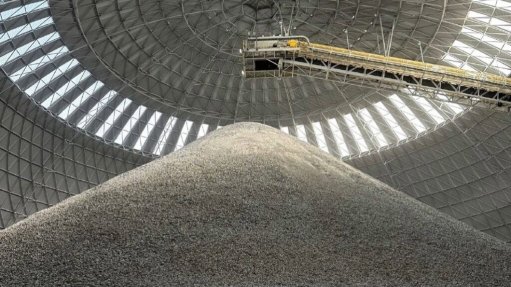Falling commodity prices changing face of the mining industry
Stumbling commodity prices have forced mining companies to take a hard look at their operational efficiencies and to re-evaluate the margins of certain projects.
In Australia, the falling gold price has resulted in massive impairments, with gold miners Newcrest and Evolution Mining reporting impairment charges of A$5.56-billion and A$384.3-million respectively during the year ended June.
The declining commodity prices have also prompted a rash of mine closures and deferrals in Australia, as low-grade operations struggle to make ends meet in the current economic climate.
Gold miner Alacer Gold is on the hunt for a buyer for its Australian assets, warning that it would place these mines on care and maintenance if one could not be secured.
Despite its Australian assets expecting to deliver a combined production of between 168 000 oz and 187 000 oz for the full 2013, Alacer believes that the projects are dragging down the performance of the company’s high-value Turkish assets.
ASX-listed Focus Minerals at the end of July suspended mining operations at its Coolgardie project, in Western Australia, blaming the decline in gold prices.
The falling gold price has also seen fellow listed Reed Resources handing over its Meekatharra gold project to administrators, after the company had announced the deferral of its Stage 2 and 3 developments at the project.
Junior Silver Lake Resources has also deferred the development of its Murchison underground mine by some 12 months, in the hope that the gold price will have increased by then.
First ore from the Caustons underground mine had been expected in the September quarter, but Silver Lake is now relying on its openpit operations to supply ore feed during the 2014 financial year.
Advisory firm Deloitte notes that the current commodity climate has resulted in the near-correction of the valuation of some assets.
“A number of projects that were deemed successful at high commodity prices are now being placed on care and maintenance, and high-grade projects are now coming into favour,” says Deloitte’s Australia-Africa services group leader Jacques van Rhyn.
“A lot of projects should likely not have been developed on their margins, and they were only developed because of the very high commodity prices. We have seen quite a few of these smaller projects, which were viable in the high commodity price, become less so now.”
Van Rhyn’s view of the industry has been reiterated by PwC, which reports that the fundamental business dynamic of the mining industry is changing.
“No longer can miners focus on expansion at any price – the so-called volume frenzy – and simply rely on high commodity prices to maintain profitability and deliver shareholder returns,” says PwC Australia’s energy, utilities and mining leader, Jock O’Callaghan.
He notes that the fluctuating commodity prices, combined with a ballooning cost base, have reduced profits and challenged asset values, which, in turn, have prompted the need for better capital investment disciplines, as well as a closer focus on productivity.
Van Rhyn points out that apart from the higher value operations, mining companies are also now looking to scale back the size of the projects under development.
“A lot of projects were being planned on a mega scale, and companies are now looking to see if there are alternative development options. They are looking to get into production in a smaller scale, and at lower capital cost.”
He adds that companies are now balancing capital spend with returns. The lower capital costs associated with the smaller project development would also make it easier to source funds for project development, and would allow the companies to go into production sooner.
Van Rhyn notes that the limited avail-ability in capital funds could also prompt more consolidation in the market.
“There are a lot of projects on the hunt for cash, but there is only so much capital to go around, and it is spread over potentially too many projects. What we will likely see, especially in areas where there are multiple projects in close proximity and where there are opportunities to jointly develop, we will start seeing consolidation,” he says.
This consolidation has already started taking place in parts of Australia, with South African gold miner Gold Fields recently announcing a A$300-million deal with TSX-listed Barrick Gold.
Gold Fields CEO Nick Holland has pointed to cost synergies between the company’s own Agnew mine and the newly acquired Lawlers mine, and has said the company will immediately work to con- solidate the two operations.
Holland adds that in addition to realising the obvious short-term operating synergies between these assets, Gold Fields also believes the consolidation of the Lawlers/Agnew operations within the Yilgarn belt will provide significant long-term benefits, allowing for the potential of this gold district to be maximised under one owner.
However, while Holland was enamoured of the newly acquired assets, he has con-ceded that the days of adding ounces, while not considering the costs, are over.
“The days of buying mines because you want to increase your ounce profile, are gone. You have to do an acquisition that will enhance your cash flow. It’s not about growth or sizing anymore, but how to improve cash delivery for shareholders.
“That is the key,” Holland says.
A recent survey conducted by advisory firm Ernst & Young (E&Y) noted that margin protection and productivity improvements in the mining sector have become a more serious concern for industry participants.
“The rising business risks that are top of mind with mining and metals CEOs and boards today are being driven by the need to protect returns and manage the interests of varied and often competing stakeholders,” said E&Y global mining and metals leader Mike Elliott.
“This is in stark contrast to just 12 to 18 months ago, when fast-tracking production was still top of the agenda and capacity constraints defined the key business risks.”
Elliott pointed out that a decade of higher commodity prices had concealed the impact of rampant cost inflation, falling productivity and poor capital discipline in the sector.
“The softening of commodity prices in 2012, the legacy of the ‘growth at any cost’ phase of the super cycle, and rising costs created a perfect storm to squeeze margins and drive down profitability.”
He added that while some of the factors squeezing margins – such as scarcity premiums for inputs or high producer currencies – would ultimately self-correct as mineral prices fell, companies still needed to address operating costs and capital allocation.
“Productivity in the sector has been on the decline for nearly a decade, across manpower, equipment, processes and logistics. Those who have tackled costs early are now focusing on optimising productivity through more judicious use of labour and equipment.”
PwC’s O’Callaghan is optimistic about the resources sector’s ability to improve productivity, despite the challenges brought on by what he calls the sector’s “unique circumstances”, including long lead times in achieving investment returns, the diminishing supply of easily-accessible ore, infrastructure and supply chain issues, and a wide-ranging skills shortage.
“With all this in mind, there remains a tremendous opportunity for companies to improve their productivity. Rather than implement austerity measures, focused and strategic changes to process improvements, de-bottlenecking and an embrace of technology can help companies deliver productivity improvements and recover their long-term financial performance,” he concludes.
Comments
Press Office
Announcements
What's On
Subscribe to improve your user experience...
Option 1 (equivalent of R125 a month):
Receive a weekly copy of Creamer Media's Engineering News & Mining Weekly magazine
(print copy for those in South Africa and e-magazine for those outside of South Africa)
Receive daily email newsletters
Access to full search results
Access archive of magazine back copies
Access to Projects in Progress
Access to ONE Research Report of your choice in PDF format
Option 2 (equivalent of R375 a month):
All benefits from Option 1
PLUS
Access to Creamer Media's Research Channel Africa for ALL Research Reports, in PDF format, on various industrial and mining sectors
including Electricity; Water; Energy Transition; Hydrogen; Roads, Rail and Ports; Coal; Gold; Platinum; Battery Metals; etc.
Already a subscriber?
Forgotten your password?
Receive weekly copy of Creamer Media's Engineering News & Mining Weekly magazine (print copy for those in South Africa and e-magazine for those outside of South Africa)
➕
Recieve daily email newsletters
➕
Access to full search results
➕
Access archive of magazine back copies
➕
Access to Projects in Progress
➕
Access to ONE Research Report of your choice in PDF format
RESEARCH CHANNEL AFRICA
R4500 (equivalent of R375 a month)
SUBSCRIBEAll benefits from Option 1
➕
Access to Creamer Media's Research Channel Africa for ALL Research Reports on various industrial and mining sectors, in PDF format, including on:
Electricity
➕
Water
➕
Energy Transition
➕
Hydrogen
➕
Roads, Rail and Ports
➕
Coal
➕
Gold
➕
Platinum
➕
Battery Metals
➕
etc.
Receive all benefits from Option 1 or Option 2 delivered to numerous people at your company
➕
Multiple User names and Passwords for simultaneous log-ins
➕
Intranet integration access to all in your organisation


















